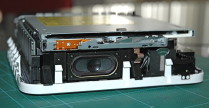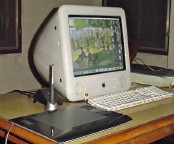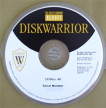|
|
Graham K. Rogers
The first two weeks were fine, with the only problems coming from software that needed to be updated, such as Little Snitch, Undercover, and Macaroni. A plug-in I use with iTunes stopped working and an update was released a few days later. Some of these companies were a little slow on letting users know that updates were necessary. Unsurprisingly, there were also updates released by Apple and the most significant were the iTunes 7.5 and QickTime 7.3 updates. As iTunes integrates with other applications and QuickTime is an important feature of the operating system, these were important.
Mac minis I have access to three Mac minis that I bought for students to use. There are two with 1.25GHz G4 processors and one with the 1.5GHz G4 chip. They are all in standard configuration.
I have access to three Mac minis that I bought for students to use. There are two with 1.25GHz G4 processors and one with the 1.5GHz G4 chip. They are all in standard configuration.
I had problems initially with the first of the 1.25GHz machines when I tried to run Disk Warrior. The disk has been problematic in the past and I did (at the company's suggestion) wash it. That fixed the problem before and it revived; but now its use as startup disk caused a couple of kernel panics. I did try starting from an external LaCie drive that I use as a rescue/backup disk, but that produced much churning and an eventual start from the computer's disk. That may well be because the LaCie drive is formatted in GUID format.
Not a chance. Much grinding away for a few minutes, but Leopard wasn't having any of it: not enough memory, thanks. After a restart, I took Disk Warrior off the 1.5GHz mini and installed it on the first one, reversing the master-slave relationship, then did the checks again. The 1.5GHz machine was also fine: Leopard was installed on this computer using the basic Upgrade method. Thus far I have had no reports from the students that there are any problems, although I want to check now for upgrades for both Apple and third-party software. With two apparent successes in my pocket, I was confident that the eMac at home would be problem-free.
eMac This 1.25Ghz G4 machine with 40G hard disk had been in heavy use when I first bought it some three years or more ago and it still works well. I had demoted it from my main computer when I bought my 12" PowerBook, and it had a temporary promotion when the PowerBook was stolen (the eMac is too heavy), but the arrival of a 2.16GHz MacBookPro meant that I was fully mobile again.
This 1.25Ghz G4 machine with 40G hard disk had been in heavy use when I first bought it some three years or more ago and it still works well. I had demoted it from my main computer when I bought my 12" PowerBook, and it had a temporary promotion when the PowerBook was stolen (the eMac is too heavy), but the arrival of a 2.16GHz MacBookPro meant that I was fully mobile again.
It is used these days mainly for Internet work: eMail, browser and Adium (MSN equivalent). It has a fair amount of older software installed, some of which had not been cleaned up for a while, although i regularly ran maintenance procedures, including Disk Warrior (3.0.3), which found only some 15% of files out of order: not perfect but not bad. Before putting on Leopard, I linked with the MacBookPro using the small home network and copied across important data, including the Pictures folder (with all older images in iPhoto) and the Mail folder. The update itself went through with no problems and all seemed fine on the restart, but the moment I tried to cancel the Apple online registration, there was a kernel panic. This was repeated a couple of times despte checks, and I did find that it had a USB camera connected (a friend now uses the computer more than me). I tried again with all external links disconected, including the Ethernet cable, and for a while it seemed as if I may have had the answer. The instant the Ethernet was plugged in, the grey screen came down and we were back to square one. Like the MacBookPro there was certain software installed that needed internet connections to function but this was a far older machine. There were also some utilities that would phone home on the startup. I had a think about this over the next 24 hours and decided that I could do one of two things: analyse the logs to find out the cause (perhaps) and fix that; or reinstall the operating system with the Archive and Install option, preserving all settings. I decided on the latter as the easier of the two choices. When I checked the disk however, the installer required some 10G or more (I had already seen the notebook computer's disk space reduced from 68G to 58G) and we had only 6G spare. I had been running it close anyway -- perhaps even that was adding to the problems -- so I was left with the analysis and repair or Erase and Install. I chose the latter. Since the reinstall, I have been rebuilding the disk and its applications. I started with Mail as I keep passwords in that application (duplicated and saved elsewhere of course), but this would be the most direct way to work with them when bringing the disk up to speed. On its initial start, Mail needs details of the main email account and these were entered. Once I had that first account working, I connected the the MacBookPro and copied the mailboxes and pictures folders back. In Mail's File menu is an item marked "Import mailboxes." I clicked that, indicated the location and all were installed in a "restored" location. As the accounts were re-added, so I dragged the mail into the correct locations. Once iLife was installed, it was a similar process to bring in the images into iPhoto and that was also working as before. At this stage, I still have a few more applications and utilities to add, but the eMac has not misbehaved at all.
MacBookPro AgainWhile the eMac has been fine, the MacBookPro began to falter after a couple of weeks and, while some would like to blame Apple, I cannot. There have been a number of little signs that we had a system that was less than 100%. Some of the actions have taken simply added to that, particularly a few days before I write this.
When creating an iSight recording in iMovie, there was a serious delay when saving the clip. I switched to another space (handy this) and carried on with other software, but when I returned a while later, the clip was still not showing as saved and the progress bar had ceased to move. After class, I force quit iMovie but on restart saw that te clip had been properly created. Likewise, trying to create a small slideshow in iPhoto -- something which could be done easily before the Leopard installation -- stopped the application. With both iMovie and iPhoto, when I tried the same process again with no projector attached, the files were properly created. I also later found that I was unable to use Front Row with these projectors. I had intended showing a QuickTime movie clip via this feature, but nothing happened with either the remote control or the (new) Front Row application. Again this worked when the projector was not connected. As I told my students, we should always have a Plan B, and I just opened the files in QuickTime and showed them full-screen, via the projector. A further problem came after the update to QuickTime. The same day, a number of the widgets installed stopped working. Among them were the Dictionary, the new movie trailers widget, and my own eXtensions widget. I did a fair amount of checking as well as dumping preferences and restarting, but all accounts on the computer were showing the same behaviour. A search of the Apple forums showed other people with the same problem and a suggestion there fixed this: empty the widgets cache (in the System>Libary folder) and anything in the users preferences folder with "widgets-com" on it. That did the trick after a logout. A couple of days later, we went downhill a bit more and I am obviously not the only one who has had problems. MacFixit who have done sterling service in tracking problems and offering advice provided several pages that I have used as resources for my own (and others') problems. Apple has also recognised some of the problems and have provided KB articles that cover the points as they come up with the answers. One useful page they have put online, links to a selection of trouble-shooting articles. A specific problem they highlighted was something I had not seen which they describe as the Finder not fully loading. They have provided a fix for this, but it does need Terminal work. DO not be afraid of the Terminal when following such instructions. It can be dangerous if you run at things without knowing what you are doing, but with clear explanations and instructions (as here) this should not be traumatic. Many users were unhapy with the way Disk Utility repairs permissions. I have noted on my computers that the progress bar does not appear until several minutes after the start button has been pressed. Initially all I see is the candy-striped bar and this is visible for most of the time. There is also the report that a file has been modified so will not be repaired, which does not inspire confidence but (apparently) is not a problem at all. We can expect this to be changed in an update to OS X (10.5.1) which is apparently in testers' hands right now.
|
|
 The MacBookPro came first of course. That is my main computer these days and I use it as both a working machine and a resource for any writing I do. As a result, it tends to have a fair amount of new software installed and I do try things that home users might not.
The MacBookPro came first of course. That is my main computer these days and I use it as both a working machine and a resource for any writing I do. As a result, it tends to have a fair amount of new software installed and I do try things that home users might not. In the end, as data was readable from the disk, I put the Disk Warrior software onto the 1.5GHz Mac mini (there had been warnings not to use a Leopard boot for the time being), linked the two using target mode and ran it from there. There was nothing wrong, so after restarting, I put in a Leopard disk and gave it a try.
In the end, as data was readable from the disk, I put the Disk Warrior software onto the 1.5GHz Mac mini (there had been warnings not to use a Leopard boot for the time being), linked the two using target mode and ran it from there. There was nothing wrong, so after restarting, I put in a Leopard disk and gave it a try. The first problems concerned graphics. I have been making a number of presentations to students on English skills and (later) on OS X -- my few classes are the only exposure most computer engineers have. While presentations were not a problem, despite the 800 x 600 resolution of the projectors, some functions misbehaved when connected to these devices.
The first problems concerned graphics. I have been making a number of presentations to students on English skills and (later) on OS X -- my few classes are the only exposure most computer engineers have. While presentations were not a problem, despite the 800 x 600 resolution of the projectors, some functions misbehaved when connected to these devices.